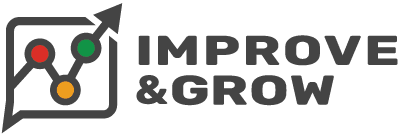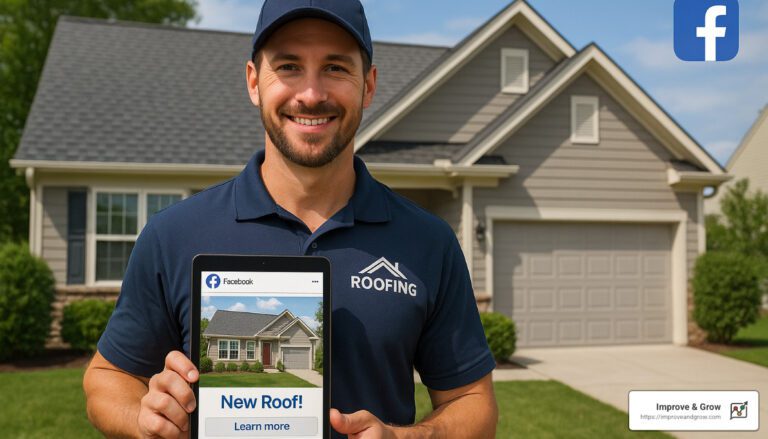Facebook Ads: The Untapped Goldmine for Roofing Companies
Ever wonder why some roofing companies always seem to have a steady stream of jobs while others struggle for leads? The secret might be sitting right in your pocket – on the Facebook app.
Roofing Facebook ads are paid promotions that target homeowners based on where they live, what they’re interested in, and key demographics that make them likely to need your services. When strategically implemented, these ads can be the difference between feast and famine for your roofing business.
“Many roofing contractors dismiss Facebook as a platform for memes, not business. That’s exactly why it represents such a valuable opportunity for those who know how to use it strategically,” says Alex Mallin, PPC Specialist at Improve & Grow. “While your competitors fight over Google keywords at $4+ per click, you can be generating qualified leads on Facebook at a fraction of the cost.”
Let’s break down what makes these ads so effective for roofers:
Facebook’s massive user base includes roughly 18% of people aged 35-44 and 25% aged 25-34 – prime demographics for homeownership and roofing services. These aren’t just casual browsers; they’re potential customers scrolling through their feeds every day, often right after a major storm has hit their neighborhood.
What truly sets roofing Facebook ads apart is the precision targeting. You can zero in on homeowners within a 15-mile radius of your service area, filter by age (typically 35-65 for best results), and even target based on interests like home improvement or recent storm activity. This means your ads reach people who actually need your services – not renters or those outside your service area.
The most successful roofing companies on Facebook combine five key elements in their approach:
First, they use hyper-local targeting to focus only on serviceable areas. Second, they create weather-triggered campaigns that launch automatically when storms hit. Third, they use compelling visuals like before-and-after photos that stop thumbs from scrolling. Fourth, they implement frictionless lead capture forms that convert 3x better than traditional website forms. Finally, they use strategic retargeting to stay in front of interested prospects who weren’t quite ready to commit.
| Key Element | Description |
|---|---|
| Cost-Effectiveness | Average Cost per Lead of $100-$200 |
| Targeting Ability | Reach homeowners by location, age (35-65), and interests |
| Ad Formats | Image, video, carousel, and lead ads |
| Audience Size | Access to Facebook’s 2.5+ billion users |
| Lead Capture | Pre-filled forms that convert 3x better than website forms |
The versatility of Facebook’s ad formats gives you creative freedom too. From single images showcasing your craftsmanship to carousel ads telling the story of a complete roof replacement, you can tailor your message to what resonates best with homeowners in your area.
When properly executed, these campaigns don’t just generate one-time leads – they build your brand’s visibility and trust in your community. The homeowner who sees your ad today might not need a roof right now, but when those first shingles start curling, guess who they’ll remember?

1. Hyper-Local Targeting: Reach the Right Homeowners
The real magic of roofing Facebook ads happens when you zero in on exactly who needs your services. Rather than shouting into the void and hoping someone hears you, Facebook lets you whisper directly to homeowners who might actually need a new roof – right in your service area.
“The days of partner categories that directly identified ‘homeowners’ are gone, but Facebook’s current targeting options actually work better when used strategically,” explains Brian Welch, Digital Marketing Strategist at Improve & Grow. “By combining geographic targeting with the right interest clusters, we can still effectively reach homeowners ready for roofing services.”
Geographic Precision
Start with your home turf. For most roofing companies, drawing a 15-mile radius around your office creates the sweet spot between reaching enough potential customers and keeping drive times reasonable. This isn’t set in stone though – adjust based on how far your crews are willing to travel and how busy you already are.
Want to get even more precise? Layer in specific ZIP codes where you’ve had successful projects before. Or target neighborhoods full of homes built in the 80s and 90s – these houses are hitting prime roof replacement age right about now.

Homeowner Interest Clusters
Since Facebook removed the direct “homeowner” targeting option, we’ve found creative ways to still reach the right people. Instead of one broad category, combine these interest pairs to find likely homeowners:
Home improvement + home repair targets people actively maintaining their properties. DIY projects + home ownership finds hands-on homeowners who recognize when a job is beyond their skills. HGTV + home renovation reaches folks inspired by home change shows, while home insurance + property insurance connects with the protection-minded homeowner.
Don’t forget about local real estate groups + home values – these people care deeply about maintaining their property’s worth, and a solid roof is essential to that.
Age Filtering
Let’s be practical – most 22-year-olds don’t own homes yet. Setting your age targeting to the 30-65 demographic instantly improves your lead quality. This simple tweak can dramatically reduce wasted ad spend on people who can’t say “yes” to your services because they’re renting or living with parents.
Advantage+ Audience Expansion
Once you’ve found a targeting combination that works, let Meta’s artificial intelligence find more people like your best customers. The Advantage+ audience tools can uncover pockets of potential customers you might have overlooked. It’s like having a digital assistant who constantly refines your audience based on who’s actually responding to your ads.
Seasonal and Weather-Based Targeting
Spring cleaning season? Focus on older neighborhoods where preventative maintenance is needed. Just had a major hailstorm? Shift your targeting to newer developments where homeowners are more likely to file insurance claims. Being nimble with your targeting keeps your ads relevant year-round.
One roofing contractor was initially targeting their entire county with ads. After implementing a layered approach – focusing on specific neighborhoods with homes 15+ years old – their cost per lead dropped by 43%. That’s the difference between paying $220 or $125 for the same qualified lead.
More info about roofing lead generation strategies
2. Weather-Triggered Campaigns: Turn Storms into Sales
When dark clouds gather and severe weather strikes, homeowner anxiety spikes—and so does the demand for roofing services. The smartest roofing contractors don’t just react to storms; they prepare for them strategically with roofing Facebook ads ready to deploy at a moment’s notice.
“The companies that win after a major storm are the ones who were prepared before it even formed,” notes Carl Lefever, Founder & Digital Marketing Strategist at Improve & Grow. “Having storm-damage campaign templates ready to deploy means you can be the first roofing company in homeowners’ feeds when they’re assessing damage.”
Mother Nature can be your most effective sales assistant if you’re prepared to respond quickly. When homeowners are standing in their living rooms looking up at water spots on the ceiling, they’re not comparison shopping—they’re looking for immediate help from the first trustworthy contractor they find.
Creating a Weather-Response System
The beauty of weather-triggered campaigns is their predictable unpredictability. We know storms will happen; we just don’t know exactly when. Your preparation starts long before the first raindrop falls.
Begin by creating templated storm damage ad sets for different scenarios—hail damage, wind damage, fallen trees—that you can customize and launch within an hour of a weather event. These should include compelling images of actual storm damage with urgent, helpful messaging.
Set up weather alerts for your service areas so you’re notified immediately when severe weather hits. Many weather services offer business alerts, or you can use IFTTT or Zapier to create automated notifications.
When a storm hits, quickly geofence the affected neighborhoods with precision targeting. This laser focus ensures your budget isn’t wasted on areas that escaped damage while maximizing visibility where it matters most.
Effective Storm-Response Ad Elements
Your storm-response ads need to strike the perfect balance between urgency and empathy. These homeowners are stressed, and your messaging should position you as a helpful guide, not an opportunistic salesperson.
Free inspection offers work exceptionally well in these scenarios. A message like “Storm damage? Get a FREE roof inspection before filing an insurance claim” addresses the immediate need while offering value upfront. This approach positions you as a trusted advisor rather than just another contractor looking for work.
Mention your insurance claim assistance capabilities prominently. Most homeowners find the insurance process intimidating, so highlighting that you “work directly with insurance companies to make storm damage claims hassle-free” removes a significant barrier to moving forward.
Create urgency triggers without feeling exploitative. Language like “Limited appointments available this week for emergency storm damage assessment” acknowledges the reality of high demand after storms while encouraging prompt action.
Include social proof specific to storm response. “Trusted by 200+ [Your City] homeowners for storm damage repairs” builds immediate credibility when homeowners are making quick decisions under stress.
“Speed is everything with storm response campaigns,” adds Alex Mallin, PPC Specialist at Improve & Grow. “Homeowners are making decisions quickly, often going with the first reputable company that contacts them. That’s why having these campaigns pre-built and ready to deploy gives you such an advantage.”
Real Results: Hailstorm Response Campaign
The proof is in the performance. One of our roofing clients in Dallas, TX implemented this exact strategy after a severe hailstorm. Within 24 hours of the storm passing, they had a campaign live targeting a 5-mile radius around the hardest-hit neighborhoods.
Their ad creative showed actual hail damage photos from the area, creating immediate recognition from homeowners seeing similar damage on their own properties. They offered free inspections with insurance claim assistance, positioning themselves as problem-solvers in a stressful situation.
What made this campaign successful wasn’t just the targeting or the creative—it was the preparation. They had their audience segments built, ad creative templates ready, and Meta Pixel tracking set up well in advance. When the storm hit, they only needed to adjust a few details and launch.
With weather-triggered roofing Facebook ads, the advantage goes to the prepared. By having your storm response strategy mapped out before severe weather strikes, you’ll be capturing leads while your competitors are still figuring out their approach.
Scientific research on Facebook ad CPM
3. Thumb-Stopping Creatives: Before-&-After, Video & Carousel Magic
The visual nature of roofing work makes it perfect for engaging Facebook ad creatives. When homeowners are mindlessly scrolling through their feeds, the right image can make all the difference between being ignored or generating a lead.
Before-and-After Changes
Nothing demonstrates your roofing expertise quite like before-and-after photos. They provide instant visual proof of your craftsmanship and the change you deliver. Your photos will have maximum impact when you:
- Capture consistent angles for both before and after shots
- Ensure proper lighting highlights the quality of your work
- Select dramatic changes that showcase real problems solved
- Include subtle branding that doesn’t distract from the roof itself

Short-Form Video Walkthroughs
Videos under 15 seconds are Facebook gold. They capture attention quickly and tell your story efficiently. For roofing companies, effective short videos might show your crew skillfully installing new shingles in a time-lapse, a brief testimonial from a smiling homeowner, or a quick walkthrough of a recently completed project.
Remember to add captions to all your videos—most Facebook users scroll with the sound off, and they’ll keep scrolling if they can’t understand your message without audio.
Carousel Ad Storytelling
Carousel ads give you a powerful way to tell a sequential story that draws viewers in. Think of each card as a chapter in your roofing story. You might start with a damaged roof, then show your crew at work, followed by the beautiful finished project, and end with a delighted homeowner.
Other effective carousel sequences include showcasing different shingle options with brief descriptions of each, or highlighting your various services from inspections to repairs to full replacements.

Creative Best Practices for Roofing Ads
While Facebook has officially retired its 20% text rule, ads with less text still perform better. Let your images do the talking and keep text to a powerful headline and brief description. Always use high-resolution images—blurry photos scream amateur and damage your credibility.
Show real projects whenever possible. Homeowners can spot stock photos from a mile away, and authentic local work builds trust immediately. Including people in your photos—whether it’s your hardworking crew or satisfied homeowners—creates an emotional connection that sterile roof-only shots miss.
Maintain consistent branding across all your creatives with your logo and color scheme. This repetition builds brand recognition over time, even among people who don’t click immediately.
Design Tools for Non-Designers
You don’t need an art degree to create effective ad creatives. Canva offers roofing-specific templates you can customize in minutes, while Adobe Express provides simple video editing capabilities even beginners can master. And don’t underestimate your smartphone camera—modern phones take photos that are more than sufficient for compelling before-and-after documentation.

Engagement rates are typically much higher after switching from generic stock photos to real before-and-after project photos in their roofing Facebook ads. The authenticity of showing actual local projects created an immediate connection with homeowners who recognized neighborhoods and architectural styles similar to their own homes.
The truth is, homeowners want to see what you’ve done for people just like them. When they can visualize your work on homes similar to theirs, they’re much more likely to reach out for a quote.
More info about social marketing for trust-building
4. Roofing Facebook Ads Lead Forms That Convert Instantly
One of the most powerful features of roofing Facebook ads is the ability to capture leads directly within the platform using Facebook Lead Ads. These forms eliminate the need for users to click through to your website, dramatically improving conversion rates—especially on mobile devices.
“The fewer steps between interest and conversion, the higher your lead rates will be,” explains Jen Leong, Digital Marketing Strategist at Improve & Grow. “Facebook Lead Ads pre-fill user information and keep the entire experience within the platform where users are already comfortable sharing information.”
Why Lead Forms Work for Roofing
Facebook Lead Ads typically convert at 3x the rate of traditional landing pages because they remove friction from the lead generation process. When a homeowner sees your ad about roof repairs after a storm, they can submit their information with just a few taps—no website loading, no unfamiliar interfaces, just a smooth process that feels natural within their Facebook experience.
The pre-filled information from the user’s Facebook profile means they don’t need to type their name, email, or phone number on a tiny mobile keyboard. This convenience is huge, especially for homeowners who might be stressed about roof damage and looking for quick solutions.
| Lead Capture Method | Avg. Conversion Rate | Avg. Cost Per Lead |
|---|---|---|
| Facebook Lead Forms | 8-12% | $100-200 |
| Landing Pages | 2-5% | $200-300 |

Crafting High-Converting Lead Forms
Your lead form doesn’t need to be complicated to be effective. In fact, simplicity usually wins. Ask for just the essentials: name, phone, email, and perhaps one or two qualifying questions that help you understand the homeowner’s needs.
Smart qualifying questions can save you time and improve lead quality. “Do you own your home?” immediately filters out renters who can’t authorize roofing work. “When are you looking to start your project?” helps prioritize urgent needs from future planning.
Always include a clear privacy policy to build trust. Homeowners want to know their information won’t be misused. And set proper expectations with text like “A roofing specialist will call you within 1 business day” so they know exactly what happens next.
Multi-Step Survey Approach
For higher-quality leads, consider warming up prospects with a progressive survey approach. Start by asking about their specific roofing needs (repair, replacement, inspection), then move to timeline questions (emergency, 1-3 months, planning ahead), and only then request their contact information.
This approach feels more conversational and less like an immediate sales grab. By the time they’re entering their contact details, they’ve already invested in the process and are more likely to be genuinely interested in your services.
Why Roofing Facebook Ads Lead Forms Outperform Traditional Landing Pages
The mobile-first design of Facebook lead forms gives them a significant advantage for roofing companies. Most homeowners browse Facebook on their phones, and traditional landing pages often create frustration on mobile devices.
“We’ve seen companies reduce their cost per lead by 25-50% by switching from landing page campaigns to Facebook Lead Ads,” notes Alex Mallin. “The combination of pre-filled information and staying within the Facebook environment dramatically increases conversion rates.”
The numbers don’t lie—with an average cost per lead of just $150 compared to $250 for landing page conversions, Facebook lead forms are simply more cost-effective. They’re designed specifically for thumb-based mobile interaction, making them intuitive for users of all ages and tech comfort levels.
Lead Generation for Roofers: 8 Proven Strategies to Get More Roofing Leads
Optimizing Roofing Facebook Ads Lead Forms with CRM Automation
The real magic happens when you connect your lead forms directly to your customer relationship management system. This automation creates a seamless workflow that turns Facebook leads into scheduled appointments without manual data entry.
When a homeowner submits a lead form about their storm-damaged roof, your team gets notified immediately. Your CRM can automatically send a thank-you text or email, and the lead gets scored based on their answers to qualifying questions. The right team member gets assigned, and they can reach out while the homeowner is still thinking about their roofing problem.
You can set up these powerful integrations using Meta Conversion API for direct CRM connections, Zapier for connecting to most popular CRMs, or native integrations with major platforms like HubSpot or Salesforce.
Speed is absolutely critical. Contacting leads within 5 minutes of form submission can increase conversion rates by up to 900% compared to waiting an hour. When a homeowner is dealing with a leaking roof or storm damage, the first company to respond often wins the business.
5. Retargeting & Follow-Up: Seal the Deal After the Click
Even the best roofing Facebook ads won’t convert every prospect on the first interaction. That’s where strategic retargeting comes in—keeping your roofing business top-of-mind as potential customers move through their decision-making process.
“Roofing is a considered purchase that often involves multiple family members and research phases,” says Carl Lefever, Founder & Digital Marketing Strategist at Improve & Grow. “Your retargeting strategy needs to nurture prospects through this journey with the right message at each stage.”
Setting Up Your Retargeting Infrastructure
Before you can effectively follow up with potential customers, you need the right digital foundation in place. Start by installing the Meta Pixel on your website—this small piece of code is like a digital tracking system that monitors how visitors interact with your site.
Make sure you configure specific event tracking to capture key actions: basic page visits (PageView), service page views (ViewContent), started contact forms (InitiateCheckout), and completed form submissions (Lead). This granular data helps you understand exactly where prospects are in their decision journey.
With your tracking in place, build custom audience segments that make sense for a roofing company. Group website visitors by timeframe (past 30, 60, or 90 days), segment by specific service pages they’ve viewed (roof replacement versus repairs), identify those who started but abandoned forms, and create a special group for previous customers who might need additional services.

Effective Retargeting Strategies for Roofers
The beauty of retargeting is that you can create different messaging sequences based on how people have already interacted with your business. Let’s look at three powerful approaches:
For those who started but didn’t complete your lead form, create an abandoned form sequence. Begin with a gentle reminder of your original offer in the first few days. If they still haven’t responded by day 4-7, sweeten the deal by adding something extra, like a free gutter inspection. By days 8-14, shift to showing a powerful testimonial from a satisfied customer to build trust and overcome hesitation.
When someone has viewed your services but hasn’t taken action, implement a consideration nurture sequence. Start by sharing educational content about roofing materials and options during days 1-5. This positions you as a helpful expert rather than just another sales pitch. During days 6-10, showcase customer success stories and reviews to build credibility. Finally, create a sense of urgency with a limited-time offer between days 11-14.
Don’t forget about previous customers! They’re gold for your business. Create a previous customer sequence that includes seasonal maintenance reminders that keep your company top-of-mind. Offer referral incentives (“Refer a neighbor and get $100”) that turn happy customers into advocates. And introduce them to additional services like gutter guards or insulation that complement their existing roof.
Optimizing Your Retargeting Campaigns
Retargeting is powerful, but it can quickly become annoying if not done thoughtfully. Implement frequency capping to limit impressions to 3-4 per week—enough to stay visible without becoming intrusive. Create 3-5 different ad creatives per audience to prevent ad fatigue and keep your message fresh.
Be smart about your audience management too. Remove recent converters from your targeting using exclusion audiences—nothing looks more unprofessional than continuing to pitch someone who’s already hired you! And don’t forget to create lookalike audiences based on your best customers to find more people who match the profile of your ideal clients.
Integrating Email and SMS Follow-Up
Facebook retargeting works best when it’s part of a coordinated multi-channel approach. Complement your social ads with automated email and SMS sequences that create a cohesive experience. Send immediate thank-you messages after form submission, follow up with helpful content like a roofing maintenance guide, provide status updates on appointment scheduling, and don’t forget to request reviews after project completion.
A roofing company implemented a comprehensive retargeting strategy and saw a 32% increase in lead-to-appointment conversion rates. The key was maintaining consistent touchpoints across both Facebook ads and email, creating a seamless follow-up experience that guided prospects toward becoming customers.
“The most successful roofing companies don’t just generate leads—they nurture relationships,” adds Jen Leong. “Your retargeting strategy is what transforms interested prospects into booked appointments and, ultimately, satisfied customers who recommend you to others.”
More info about PPC ads for home service contractors
6. Budget & Bidding Blueprints: Spend Smart, Scale Fast
Creating compelling roofing Facebook ads is just half the journey—the other half is knowing how to invest your marketing dollars wisely. With a strategic approach to budgeting and bidding, even modest ad spend can deliver impressive results for your roofing business.
“Many roofing contractors fall into one of two traps: they either underspend and miss valuable opportunities, or they throw too much money at campaigns without proper tracking,” explains Alex Mallin, PPC Specialist at Improve & Grow. “The sweet spot is where your budget consistently generates leads at a cost that keeps your business profitable.”
Setting Your Initial Budget
If you’re new to Facebook advertising for your roofing business, here’s a practical approach to get started:
Begin with a test budget of $1,000-$1,500 per month at minimum. This gives Facebook’s algorithm enough data to optimize your campaigns effectively. Divide this budget across different campaign objectives, with about 60% going toward lead generation campaigns that directly bring in potential customers. Allocate roughly 30% to traffic and consideration campaigns that build awareness, and the remaining 10% to retargeting campaigns that follow up with people who’ve already shown interest.
![]()
Most importantly, commit to at least 90 days of consistent advertising. Facebook campaigns need time to gather data and optimize—quick judgments based on a week or two of performance often lead to missed opportunities.
Daily vs. Lifetime Budget Strategies
Facebook offers two primary budget structures, each with distinct advantages for roofing campaigns:
Daily budgets work wonderfully for ongoing lead generation efforts where you want a steady stream of potential customers. They’re also perfect for testing new audiences or creative approaches since they provide consistent data. If your roofing business needs a predictable flow of leads day after day, this approach makes the most sense.
Lifetime budgets, on the other hand, shine for weather-triggered campaigns after storms hit your area. They’re also ideal for special promotions with definite end dates, like seasonal discounts or limited-time offers. This approach gives Facebook more flexibility to spend your budget when it’s likely to get the best results, even if that means spending more on certain days and less on others.
Bidding Strategies That Maximize ROI
While Facebook offers several bidding options, three strategies typically deliver the best results for roofing companies:
The Lowest Cost bidding strategy (formerly called automatic bidding) lets Facebook optimize to get you the most leads within your budget. This works well for most roofing campaigns, especially when you’re starting out.
When you know exactly how much you can afford to pay for a lead, the Cost Cap option lets you set that ceiling. Facebook will then work to get you as many leads as possible without exceeding your maximum cost per lead.
For campaigns targeting multiple audience segments, Campaign Budget Optimization (CBO) allows Facebook to distribute your budget across different ad sets based on performance. This automated approach often finds opportunities you might miss when manually allocating budgets.
Calculating Your Break-Even CPC
To make data-driven decisions about your advertising spend, you need to know how much you can afford to pay for leads:
Start with your average roofing job value—let’s say $12,000. Calculate your typical profit margin on jobs—perhaps 30%, which equals $3,600 in profit. Then estimate your lead-to-customer conversion rate—maybe 20% of qualified leads become customers. Multiply your job profit by your conversion rate ($3,600 × 20% = $720), and you’ll know your maximum cost per lead to break even.
“Understanding your customer lifetime value and conversion rates transforms Facebook advertising from guesswork into a data-driven decision,” notes Carl Lefever. “This prevents emotional reactions to campaign costs and keeps the focus where it belongs—on ROI.”
Scaling Successful Campaigns
Once your campaigns start delivering consistent results, it’s time to scale strategically:
Increase your budget gradually—aim for 20% increases every 3-5 days rather than doubling overnight, which can disrupt the algorithm’s learning. Consider expanding your geographic targeting to include neighboring service areas where you’re willing to work. Create lookalike audiences based on your converted leads to find more people similar to your best customers. And don’t forget to test new ad formats—if static images are working well, try video or carousel versions of the same message.
Conclusion
Roofing Facebook ads have emerged as a game-changing lead generation channel for forward-thinking contractors. When implemented with the strategic approach we’ve outlined, these campaigns can deliver consistent, qualified leads at a fraction of the cost of traditional marketing methods.
“The most successful roofing companies we work with view Facebook not just as an advertising platform, but as a key component of their overall growth strategy,” shares Carl Lefever, Founder & Digital Marketing Strategist at Improve & Grow. “They’re building sustainable marketing assets while their competitors fight over the same Google keywords at premium prices.”
Throughout this guide, we’ve explored the critical elements that make roofing Facebook ads work:
Hyper-local targeting lets you zero in on homeowners in your exact service area, focusing your budget where it matters most. By combining geographic precision with interest-based targeting, you can reach the right homeowners at the right time.
Weather-triggered campaigns transform severe weather events into business opportunities. Having storm-damage campaigns ready to deploy means you’ll be the first roofing company homeowners see when assessing damage after a storm hits.
Compelling visual content stops thumbs mid-scroll. Your before-and-after photos, short videos, and carousel ads showcase your craftsmanship and build trust with potential customers who need visual proof of your expertise.
Lead forms that convert capture prospect information directly within Facebook, eliminating friction and dramatically improving conversion rates. With pre-filled information and no website loading delays, these forms typically generate leads at $100-200 each—far below what most contractors pay through other channels.
Retargeting strategies nurture prospects through their decision-making journey. By keeping your company top-of-mind with strategic follow-up across multiple touchpoints, you transform interested prospects into booked appointments.
Budget and bidding blueprints ensure you’re maximizing every dollar spent. With proper tracking and data-driven decision making, even modest budgets can generate significant returns when allocated strategically.
At Improve & Grow, we focus on delivering a 10X return on investment through integrated digital marketing strategies. While Facebook ads are powerful on their own, they become truly transformative when combined with a conversion-optimized website, strong local SEO, and strategic Google Ads campaigns.
“Facebook advertising excels at filling your pipeline with qualified leads today, while simultaneously building brand awareness that pays dividends for years to come.” notes Carl Lefever.
Ready to transform your roofing business with a Facebook ad strategy that delivers consistent, qualified leads? Improve & Grow specializes in helping roofing contractors develop and implement digital marketing strategies that generate measurable results and sustainable growth.





